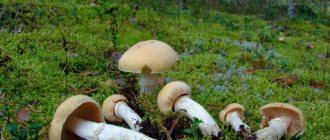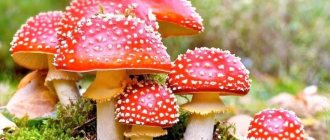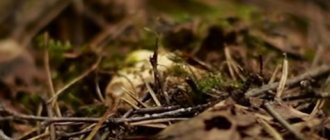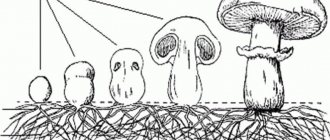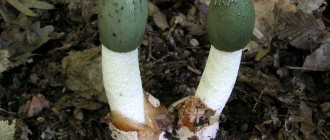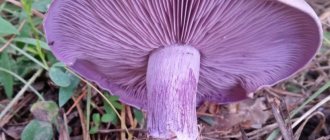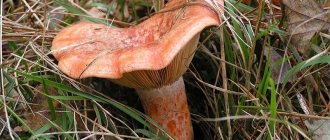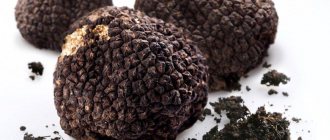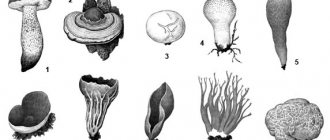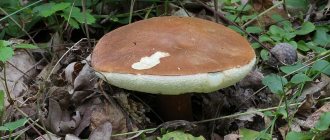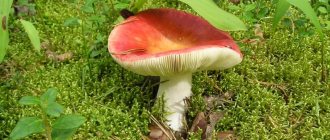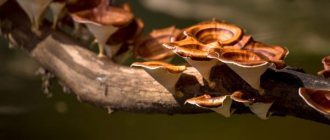What is another name?
This is a little-known mushroom. Many have not even heard of it, and when they come across it, they pass by, not suspecting what kind of gustatory pleasure they are depriving themselves of.
The official name of the chickens is ringed cap. It belongs to the genus Rozites (Rozites caperatus). Despite its low rating among mushroom pickers, it has many popular names. In addition to “chicken” names, his name is:
- white marshland;
- cap;
- greenfinch;
- gray sandpiper;
- green grass.
Sometimes it is called the “gray rower,” but it does not belong to their family. It differs from the real gray row in color and structural features of the leg.
Other name
The scientific name for bettas is ringed cap. This is the only representative of the European species of mushrooms of the genus Rosites, which is sometimes included in the genus Cobweb. In Latin its name is written Rozites caperatus.
There is also a synonym - chicken mushroom, and a number of popular nicknames that were given to it by residents of different regions:
- white marshweed,
- dull rosetes,
- Turk,
- cap,
- greenfinch,
- gray sandpiper,
- Greenweed.
It is often called “gray row,” but in fact these are completely different species. Gray rower (Tricholoma portentosum) belongs to the Ryadovkov family and is distinguished by a dark gray or brownish cap color; in addition, her leg does not have a ring.
Features of cockerels
Chickens, indeed, are somewhat reminiscent of toadstools. They are just as shaky and weak. To avoid getting toadstools instead of tasty cockerels, you need to know the exact description of the mushroom:
- Hat. This is the most noticeable part of bettas, so it is worth studying it in detail. The ringed cap, from a young age, has a rounded cap, shaped like an egg. The edges are slightly curled downwards. The color is slightly brownish - similar to the shades of chicken eggs. The diameter of the cap for young fungi is 5 cm, for old ones it is 10-12 cm. As they grow, the ovoid cap unfolds, turning into a cap. The edges are aligned, and the torn film forms a ring around the leg. The plates overgrown with spores are initially light yellow. As the males grow, the plates darken. In old mushrooms they are rusty or light brown in color. The top of the cap is riddled with cracks and covered with a light whitish coating.
- Leg. The chicken has the most common one. It reaches 12 cm in length. Thickness is up to 3 cm. Shape is cylindrical. Below there is a slight thickening. There is a film membrane. The lower part is smooth, the upper part has a slight coating. Color – light yellow.
- Pulp. Its taste is similar to champignons. It has a fibrous structure. Dense, but somewhat watery. Color – white. Often affected by worms.
Experienced mushroom pickers talk in a video about the features of the ringed cap - what it looks like, where it grows, why it is interesting:
How to use in cooking
Cockerels are gastronomically versatile; they can be eaten in any form.
Taste qualities
These mushrooms have a unique, delicate, specific taste unique to them. Due to its delicious taste, rooster dishes are reminiscent of tender chicken. Their nutritional properties are not inferior even to champignons.
What are they suitable for?
The versatility of cockerels is evident in the fact that they can be prepared in different ways:
- Marinate for the winter.
- Dry.
- Fry.
- Stew.
- Salt it.
- Boil in soup.
- Use as an ingredient in solyankas.
They go harmoniously with any vegetables, meat, and spices. The caps of young mushrooms are considered the best in taste. If the mushroom is old, with a hardened stem, it is better to discard it, even if it is not wormy.
How long should you cook?
Some gourmets like to boil cockerels before frying or stewing them. Other lovers of forest products prefer to fry them fresh. Both options are acceptable if the mushrooms grew in an environmentally friendly area. If you choose the first option, then you need to do this in 3 passes, each time draining the water and filling it with new one. And do not boil them for a long time - 5 minutes each time is enough. One of the reasons why it is advisable to boil the mushrooms several times is sand stuck between the plates.
Where and when does it grow?
Chickens prefer to grow in mountain and foothill forests. Growth time is from August to October. Favorite places:
- near the blueberry fields;
- next to a low birch tree;
- under the beech trees;
- in deciduous forests.
Mushrooms choose their “favorites” in the plant world. Living close to them, mushrooms form mycorrhiza - this is a fungal root, which is a product of symbiosis of fungal mycelium and the roots of higher plants.
Habitat: Europe, North America, Japan. The cockerels, as we see, have “scattered” all over the world. They can be found even in Greenland and Lapland. The mushroom can grow high in the mountains - up to 2,500 m above sea level. Chickens love acidic and podzolic soils - here they settle in entire colonies. This mushroom is widespread in the forests of Belarus; in Russia it can be found in swampy areas.
The mushroom is ready for collection from the beginning of July until frost. Knowing the cap's love for acidic soils, you should look for it in swamps and blueberry fields. Bettas grow in colonies, making them tempting prey - you can quickly get a full basket.
Mushroom value
Cockerels are a desirable product in cooking. They are edible, and you can cook them as your heart desires. The calorie content of the mushroom is 22 kcal per 100 g. Nutritional value of 100 g of the ringed cap:
- protein – 3.09 g;
- carbohydrates – 3.26 g;
- fats – 0.34 g.
The ringed cap also contains:
- water – 92.45 g;
- fiber – 1 g;
- sugar – 1.98 g.
Mushrooms are rich in vitamins C and D, thiamine, riboflavin, minerals - calcium, magnesium, selenium, zinc, phosphorus, iron, potassium, sodium and other useful elements.
Chickens are a valuable product; they taste like champignons. In Russia, this mushroom is undervalued, but in Europe it is considered a delicacy and is even grown artificially.
It’s not for nothing that this mushroom is called such delicate food names – hens and cockerels. The ringed cap is not only edible, but also versatile - it can be prepared in any way. Chickens are classified in the 4th food category, which indicates their low nutritional value.
All restrictions on the consumption of cockerels are associated with a characteristic feature of mushrooms - they accumulate heavy metals present in the environment in their bodies. Therefore, they cannot be collected near roads and in environmentally unfavorable areas.
Harm and benefit
Caps, like other mushrooms, have medicinal properties. But they can also cause harm.
Beneficial features
- Regular consumption of this mushroom reduces blood sugar and cholesterol levels, normalizes blood pressure, fights arrhythmia, and reduces possible risks of cancer and infectious diseases.
- The product is a good antioxidant and has antiviral and anti-inflammatory effects.
- In some countries, the mushroom is used to remove kidney stones.
- Mushroom pickle is considered an excellent hangover cure.
How to cook?
The cap can be boiled, fried, salted and pickled. The gastronomic qualities are very similar to the well-known champignons. The caps are more often eaten; they have a milder taste and are less likely to contain insect larvae. Mushrooms are used to prepare soups, main courses of meat, vegetables, and poultry.
Prolonged heat treatment affects the taste of the product, for this reason it is added at the final stage of preparation. The cap does not have as pronounced a taste and aroma as other mushrooms; it is better to mix it with other varieties.
Raising cockerels
These mushrooms are delicious and easy to harvest and cook. It is not surprising that such a tasty representative of the mushroom kingdom is grown artificially.
Growing on stumps
Most often, stumps left after cutting down trees are used for cultivation. Growing order:
- First you need to get the spores. The caps of mature cockerels are placed on a sheet of paper so that the spores can spill out. Pour the resulting seed into a small container of water.
- Water with spores is poured onto the stumps.
- From time to time, the stumps are watered with water.
Chickens grow best on pine, spruce, birch and aspen stumps or on logs of these species.
The substrate is “infected” with fragments of rotten stumps with the mycelium of the cockerels that grew on them. Take “seed material” from an area where chickens grow in colonies. Methods of infection with stump fragments with mycelium:
- Cavities are made in the infected stumps and grafting wood is placed there.
- Material with mycelium can also be secured to the end of stumps with nails. And to retain moisture, the grafting mycelium is covered with spruce paws or pieces of moss.
Chickens can be raised this way throughout the entire growing season. Unless in the heat and drought you shouldn’t hope for a harvest. The mushroom grows best in spring and summer. Amateur mushroom growers say that caps grow on contaminated material for 5-8 years.
Growing on logs and wood waste
Caps can also be grown:
- On wooden blocks. Take round scraps of wood 30-40 cm long and 15 cm in diameter. The scraps are harvested in spring or autumn. Moreover, only freshly cut trees are suitable. Chocks infect like tree stumps. But they must first be kept in a dark room. The aging period is 2-3 months. Favorable temperature is 15-20°C. Next, the logs are placed vertically in holes 20 cm deep. The laying interval is 50 cm. Infected areas, just like on stumps, are covered with spruce paws. Here the cockerels will bear fruit twice a year for 2-3 years.
- On wood waste . The method is good for growing indoors. You can use shavings, wood chips, sawdust - they are placed in glass jars or pots. They take sawdust and shavings. Mix and pour boiling water. Add starch (7.5 g per 1 kg of mixture), bean flour (15 g), oatmeal and corn flour (25 g each). The mixture is poured into sterilized jars. Sterilization time – 1 hour.
For breeding, you can use wooden boxes or plastic bags. Nutritional supplements may vary. Along with flour and starch, you can use:
- beer wort;
- malt;
- potato pulp.
Cockerels are a delicious product that deserves the attention of mushroom gourmets. Behind its unpresentable appearance lies an amazingly delicious mushroom, which in the nutritional rating can easily rank next to champignons and porcini mushrooms.
Rules for eating
The structure of the chicken pulp resembles chicken breast fibers. Despite the fact that, in terms of its taste, the mushroom belongs to the fourth category, connoisseurs of caps celebrate them as a delicacy dish.
Useful properties and restrictions on use
Caps, like many edible mushrooms, have medicinal properties in moderate doses, but also a number of contraindications. Useful properties include:
- lowering cholesterol and sugar levels;
- prevention of arrhythmia;
- prevention of infectious diseases and oncology;
- normalization of blood pressure;
- Mushroom pickle is a folk recipe for a hangover.
Among the contraindications are the following:
chronic pancreatitis; dysbacteriosis; age up to 6 years (do not use at all), from 6 to 14 very carefully due to the immature enzymatic system; mono-diets using mushrooms; allergic reactions, both to mushrooms and during the period of activity of any other allergy; chronic diseases (reduce to once every two weeks).
Treatment
Since chicken mushrooms are edible mushrooms, it is not necessary to boil them if you are planning a different cooking method. It is enough to clean well of forest debris, cut off the remains of the mycelium, cut out wormy places, rinse thoroughly under running water and dry a little. The stems of old marsh plants are not used, as they harden, and the spore apparatus on the inside of the cap is cut off, since the spores are not digested.
Cooking features
As already mentioned, it is not necessary to boil the caps, but if the collection site was close to the city or contaminated areas, you should boil the mushroom in order to remove all the accumulated dirt from it, which it absorbs like a sponge.
For this, it is important not how long to cook, but how often to change the water. The best way is to boil it three times for five minutes after boiling, then drain the water.
If boiling is part of the recipe, then they will be ready 10-15 minutes after boiling.
Marinating and salting
You can salt the swamps using hot or cold methods. Ideally salted in an oak barrel. To prepare a barrel for cold salting, you need to wash it well and steam juniper branches in it, which will disinfect the barrel for further manipulation.
Peeled and washed mushrooms are placed in layers in a barrel. For one serving you will need 5 kg of product. Each layer is well salted. This amount will require 350 g of salt. The contents of the barrel are filled with cold water and covered with a wooden lid of smaller diameter under pressure. It’s hard to take one that can be calcined and steamed with juniper. Within 7 days, the foam that forms in the barrel is removed.
At the end of the week, the water is drained, the barrel is rinsed with clean water and dill with seed umbrellas is placed at the bottom. The mixture is being prepared for re-salting. For 5 kg of the main ingredient, take 150 g of salt, 10 g of cloves and 15 g of allspice. Everything is mixed and salted in each layer. It is again filled with clean cold water and sent under oppression for 1.5 months in a dark, cool room.
A faster option for hot salting. To do this, you will first need to boil the peeled mushrooms for 5 minutes 2 times, changing the water. For the brine, take 2 liters of water, add 75 g of salt, 3 allspice peas, 2 pcs. cloves, 5 black peppercorns. Let the brine boil for a couple of minutes and add the mushrooms squeezed out of the water and cook for 5 minutes.
Prepare liter jars by sterilizing them first. Place a bay leaf, 3-4 cloves of garlic, and 2-3 onion rings into each jar. Pour boiling brine into the jars along with the mushrooms and roll up with iron lids. After cooling, store in the refrigerator or cellar.
To marinate the caps, you must also first boil them once and drain the water. Further methods of marinating are very variable and vary depending on the recipe. But the classic marinade recipe is similar for all mushrooms. Rosites are poured with cold water and brought to a boil. Add cloves, black pepper, allspice, and bay leaves to the water to taste. The mushrooms are boiled in the marinade for about an hour, then sealed in sterilized jars.
Description of the mushroom Ringed cap
The ringed cap is a mushroom that in Europe is valued in terms of taste on a par with champignon. In our country, chicken mushrooms (as caps are called) are not widespread. They are collected only by experienced mushroom pickers. Descriptions of the chickens will help you avoid mistakes during collection and preparation.
Description of the mushroom Ringed cap
Medicinal properties and medicine
Among the people, healers called the cap “chicken mushroom”. Not so much because of the appearance, but because of the taste properties that appear after cooking. Indeed, the mushroom was used to make medicinal decoctions.
However, in today's modern Russia, the healing properties of the ringed cap are little known. However, among our neighbors, in Belarus, this mushroom is very common. It is used as a medicinal component for a number of serious diseases.
Very often it is used as a compress for enlarged lymph nodes and other tonsillitis diseases.
In the Baltics, this mushroom is also widely used for its medicinal properties. For example, they make a decoction of mushrooms. To do this, the ringed cap is collected in an amount of 500 g and placed in a three-liter pan. Boil for several hours, then strain thoroughly. This decoction is used to treat the kidneys and also help remove stones from the body.
In Poland, it is believed that the brine that remains after these mushrooms is an ideal hangover reliever, even better than medications. This solution is also used to rub swollen limbs and make compresses.
However, if we think more intelligently and turn to scientific medicine, then, unfortunately, we will not find any mention of the fact that the mushroom has truly healing properties. Moreover, Rosites is not included as a healing component in any composition of medications, which also speaks volumes about its importance for medicine.
Description of the mushroom
The annular cap mushroom is a lamellar mushroom. There are several names for this variety: rosetis, turk, swamp grass, cockerels (greens), goose. Gray rowers are sometimes mistakenly called chickens.
The description will help you recognize the cockerel and distinguish it from poisonous varieties:
- the cap is ovoid or spherical, the edges are adjacent to the stem;
- the color of the cap is pinkish-brown, reminiscent of the color of chicken egg shells;
- the diameter of the cap of young marshworts is 4-4.5 cm, of adults - 9-11 cm;
- the leg is cylindrical at the base, slightly swollen;
- the plates of young mushrooms are yellowish; as the spores mature, they darken to a rusty color.
As the marsh grass grows, the shape of its cap changes. A hump appears in the center, the edges diverge to the sides, and a skirt made of torn film remains on the leg. Over time, the skirt dries out, leaving only the headband on the leg. Over time, the edges of the cap dry out and crack, and the cracks move toward the center. The spores of an adult fungus leave an ocher-colored coating on the hands.
The cap of the chickens is wrinkled, it is covered with a white coating, which becomes scales at the edges. They make the cockerel look like a fly agaric. The difference is their location only along the edge. The similarity with the fly agaric is also given by the widened leg at the base. Rosetis lack a sheath around the thickening.
Rosetis grow in pine and mixed forests, near swamps in the Leningrad region. Caps begin to be collected in mid-summer (after July 10) before the first autumn frosts. They form groups, sometimes growing in circles, which are called “witches”.
The cap is wrinkled, it is covered with a white coating, which becomes scales at the edges
Poisonous mushrooms
The ringed cap is easy to confuse with the cobweb. Cobwebs are a fungal genus, most of whose members are poisonous. They also have ocher spore powder and many of the external characteristics of hens. It is better to go for the marshlanders in the company of an experienced mushroom picker.
The group of edible caps often includes false mushrooms, pale toadstools, and white fly agarics. During collection, it is important to carefully examine and smell each one. A distinctive feature of toxic mushrooms is the white color of the plates, which does not change with age.
What mushrooms can be confused with
The annular cap can be confused with inedible mushrooms of the genus Cobweb. However, edible ones have a very important difference - they always have a full ring on their stem, which poisonous ones do not have. On them you can see only small remnants of the coverlet on the leg. Sometimes cockerels are confused with the toadstool or fly agaric.
So that you can distinguish them from their deadly counterparts, here are a few important signs:
| Name of the mushroom |
fly agaric
Beneficial features
Forest champignon contains amino acids, enzymes, vitamins, and valuable minerals in its pulp. It has the following beneficial properties:
- increases the body's resistance to infections;
- reduces the harmful effects of free radicals;
- calms the nervous system;
- increases stress resistance;
- improves digestion.
Only real edible ringed caps bring benefits. It is important to assemble and prepare them correctly.
contains amino acids, enzymes, vitamins and minerals in the pulp
Contraindications
The ring cap is not useful for everyone. It should not be used:
- small children;
- pregnant women;
- patients with ulcers or gastritis;
- patients with renal or liver failure.
It is prohibited to eat swamps collected near a highway, a large industrial enterprise, or a garbage dump. Hoods quickly accumulate toxins from the environment. Symptoms of intoxication are nausea, vomiting, headache, frequent diarrhea, cutting pain in the abdomen.
Application
The pleasant taste and smell of Turks, as well as the unique nutritional composition, allow them to be widely used in cooking. It is recommended to process only freshly harvested rosetis.
Marsh plants are not used in folk medicine. This is due to their low popularity among the population.
Use in cooking
Chicken mushrooms, like champignons, are eaten in different forms. Chickens (White) are salted, marinated, fried, stewed, added to soups, meat dishes, salads, and sauces are prepared based on them. Mushrooms frozen for the winter retain all their beneficial properties.
Before preparing the dish, the collected swamps are shaken off the ground, washed under running water, and boiled in filtered water for 15-25 minutes.
How to cook delicious chicken
The ringed cap is classified by many mushroom pickers as a gourmet mushroom, whose taste qualities are not inferior to the famous and most “noble” varieties. Such mushrooms can be harvested for future use or used to prepare first and second courses. It must be remembered that mushroom preparations must be stored in a cool basement or refrigerator at a constant temperature of 0-6°C.
Pickling
Peel the fruiting bodies, separate the caps and cut into two or four pieces. Prepare a marinade from a liter of water, half a glass of 9% table vinegar, three cloves, one bay leaf, eight black pepper, 70 g granulated sugar and 30 g salt. Place the mushrooms in boiling water and boil for a quarter of an hour, then quickly cool in running water. Cold mushrooms are dipped into a boiling marinade, and after a couple of minutes they are placed in hot and sterilized glass jars, which are rolled up with lids.
Pickling
Rinse thoroughly in running water and boil the mushroom caps for a quarter of an hour, then quickly cool under running water and salt in layers using coarse rock salt. The standard salt consumption is approximately 350-370 g per bucket. It is allowed to top the pickled mushrooms with black currant and horseradish leaves. Oppression is installed on top. With this method of salting, the chickens are ready for consumption in about a month and a half. It is best to store fully prepared salted mushrooms in the basement or in a regular household refrigerator.
Clear and aromatic mushroom soup
After washing in running water, small mushroom caps are cut in half or into four parts, and larger ones are cut into fairly small pieces. Then you need to cut the onions, parsley root and carrots into slices, then boil them in water until half cooked.
Chicken mushrooms
Most experienced mushroom pickers have no idea what a chicken mushroom looks like. Although we can say with confidence that they encountered them, they simply did not pay attention. After all, chicken mushrooms look like toadstools and rarely cause appetite, like the same boletus. And even in the photo, from a beautiful angle, they do not cause delight.
But they don’t pay attention to this variety of mushrooms in vain. The description of this mushroom in many European countries suggests that its taste is almost similar to the well-known champignons.
What they look like
In order not to chop toadstools instead of these mushrooms, you need to have a good idea of what chickens generally look like. The cap of the ringed cap is rounded and resembles the shape of an egg. The color of the cap has a slight brownish tint (the color is very close to the color of a chicken egg shell). The diameter of the hat of a young mushroom is approximately 5 centimeters, while that of old mushrooms has an average diameter of 10 centimeters.
Initially, in its young state, the mushroom resembles a leg with a chicken egg on it. Over time, as the chicken begins to age, its cap begins to unfold. It begins to turn into a real cap. The edges begin to align, the film between the inside and the cap breaks and forms a ring.
If you turn the mushroom over, you can see plates that over time become overgrown with spores. In young fruits, the plates have a light shade. But with age, the color becomes darker. When the cap is closed, its plates are light yellow; when the cap opens, the color changes to dark yellow. As it ages, the color becomes rusty and light brown.
The top of the cap is covered with wrinkles and a light white coating. In some places the plaque accumulates and somewhat resembles the white spots of a fly agaric. The largest clusters form near the edges of the cap.
The chicken leg is straight, with a ring film in the middle. The very bottom is slightly thicker than the base of the hat. The surface is smooth, but closer to the top it may have a slight coating. The color of the leg is pale yellow. As you get closer to the root it becomes more pronounced.
Where do they grow
Despite its slight popularity, the mushroom grows in many European and Asian countries. Also common in the States.
The best soil for the development of colonies is considered acidic. You can determine the acidity of the soil by the plants that grow on it. If blueberries come into view, then with 100% certainty we can say that somewhere nearby there is a family of chickens.
There are a lot of chickens in Belarus. Also, they are common in central Russia in marshy areas.
They can be collected from the beginning of July until the onset of frost. These are family fruits that grow in groups. Often, the group forms a semicircle.
Unfortunately, most people consider swampweed to be poisonous and avoid it. But experienced mushroom pickers who were lucky enough to try chicken “meat” assure that they have no equal in taste.
